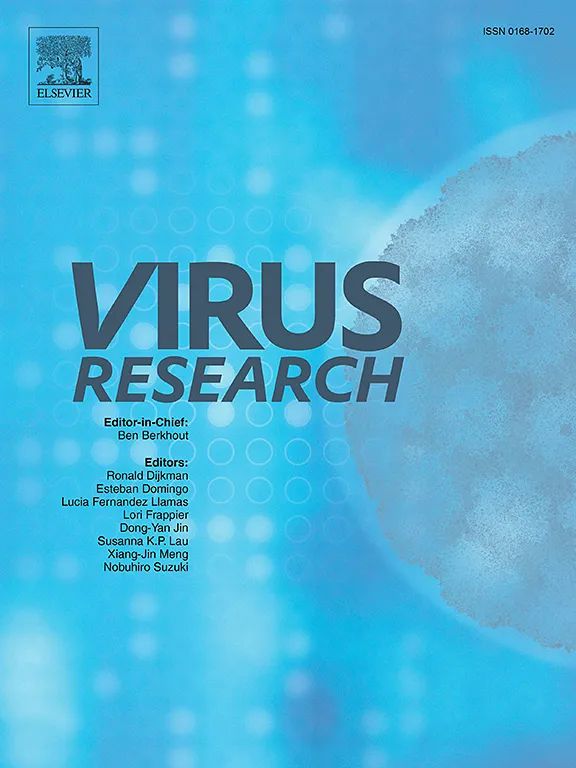Evolutionary characterization and pathogenicity of Senecavirus isolated from Shandong, China
IF 2.7
4区 医学
Q3 VIROLOGY
引用次数: 0
Abstract
Senecavirus A (SVA), previously called Seneca Valley virus, belongs to the family Picornaviridae, species Senecavirus A, in the Senecavirus genus. SVA infection causes vesicular lesions in sows and a sharp drop in neonatal piglet production. In this study, an SVA strain, SVA/SD/2023, was isolated from a pig farm in North China, and its genome was determined and analyzed. PCR, immunofluorescence, and western blotting revealed that the SVA/SD/2023 strain stably promoted the proliferation of BHK-21 cells. Electron microscopy showed that the purified virus was an icosahedral particle of approximately 27 nm in diameter. The 7286-nucleotide (not including the poly-A tail) genome of SVA/SD/2023 presented typical picornavirus features, including a single open reading frame of 5836 nucleotides encoding a 1604-amino-acid polyprotein.
The amino acid sequence of the SVA/SD/2023 strain was highly conserved (from 87.8% to 99.4% homology) with 47 reference strains isolated from different regions. Phylogenetic analyses revealed that the SVA/SD/2023 strain shared the highest sequence homology (99.4%) with the USA/IA46008/2015.
Animal regression tests revealed that infected animals demonstrated reduced appetite, fever, and depression, among other negative effects. SVA did not cause animal death. Increased Senecavirus A VP2 and neutralizing antibody levels were detected in the infected animals, and viral loads decreased with increasing antibody titers. Interestingly, the specific damage caused by viruses varied among different routes of infection. This study provides basic information for the subsequent exploration of SVA pathogenic mechanisms and disease progression.
山东塞内卡病毒的进化特征和致病性。
塞内卡病毒A (SVA),以前称为塞内卡谷病毒,属于塞内卡病毒属小核糖核酸病毒科塞内卡病毒A种。SVA感染在母猪中引起水疱性病变和新生儿仔猪产量急剧下降。本研究从华北某猪场分离到一株SVA/SD/2023,并对其基因组进行了测定和分析。PCR、免疫荧光和western blotting结果显示,SVA/SD/2023菌株稳定地促进了BHK-21细胞的增殖。电镜显示纯化后的病毒为二十面体颗粒,直径约27 nm。SVA/SD/2023的7286个核苷酸(不包括poly-A尾)基因组呈现典型的小核糖核酸病毒特征,包括一个5836个核苷酸的开放阅读框,编码1604个氨基酸的多蛋白。菌株SVA/SD/2023的氨基酸序列高度保守,同源性在87.8% ~ 99.4%之间,与来自不同地区的47株参考菌株同源性较高。系统进化分析显示,菌株SVA/SD/2023与菌株USA/IA46008/2015序列同源性最高(99.4%)。动物回归测试显示,受感染的动物表现出食欲下降、发烧和抑郁等负面影响。SVA没有造成动物死亡。在感染的动物中检测到增加的塞内卡病毒A VP2和中和抗体水平,病毒载量随着抗体滴度的增加而下降。有趣的是,病毒造成的具体损害在不同的感染途径中有所不同。本研究为后续探索SVA发病机制及疾病进展提供了基础资料。
本文章由计算机程序翻译,如有差异,请以英文原文为准。
求助全文
约1分钟内获得全文
求助全文
来源期刊

Virus research
医学-病毒学
CiteScore
9.50
自引率
2.00%
发文量
239
审稿时长
43 days
期刊介绍:
Virus Research provides a means of fast publication for original papers on fundamental research in virology. Contributions on new developments concerning virus structure, replication, pathogenesis and evolution are encouraged. These include reports describing virus morphology, the function and antigenic analysis of virus structural components, virus genome structure and expression, analysis on virus replication processes, virus evolution in connection with antiviral interventions, effects of viruses on their host cells, particularly on the immune system, and the pathogenesis of virus infections, including oncogene activation and transduction.
 求助内容:
求助内容: 应助结果提醒方式:
应助结果提醒方式:


